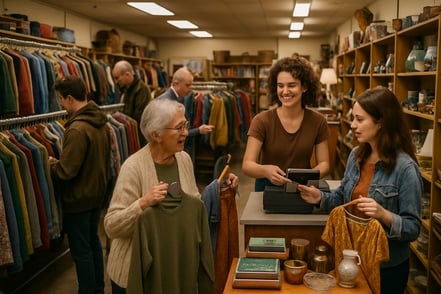
Do you ever feel like your thrift store is just going through the motions?
The racks are full, the prices are low, but something’s missing — that spark that makes customers care about what they’re buying and why it matters.
Your thrift store has a purpose. You’re doing work that makes a difference — for the planet, for people who need affordable options, for your community. When you share that purpose in a genuine, human way, your customers connect with you. They become part of your story.
So, how do you do this? How do you communicate in a way that feels authentic, builds community, and gets people excited about secondhand shopping?
Let’s dive into some mission-driven marketing strategies that can bring your thrift store’s story to life.
1. Define Your Mission
Your mission shouldn’t be some corporate statement gathering dust on your website.
It’s what guides every post you make, every sign you put up, and every conversation you have with a customer.
When you’re staring at a blank Facebook post, dealing with a tough customer complaint, or deciding whether to try a new idea, your mission is your north star.
Here’s how you can make your mission statement meaningful:
- Keep it short, positive, and human: Nobody remembers long mission statements full of buzzwords.
- Show the difference you’re making: If your thrift store supports homeless services, try something like, “Every item helps someone get back on their feet.” It’s short, memorable, and clearly communicates the impact of your store.
- Test it with real people: Share your mission statement with a few regular customers or volunteers and ask them what they think it means. If they can’t explain it back to you in their own words, it needs work.
2. Pick Your Channels Wisely
You don’t need to be on every platform. You just need to be where your people are.
Traditional outlets still work, especially with older shoppers. For example:
- Local newspapers, radio, and TV
- Community bulletin boards
- Postcards for your big sales and events
But digital is where most people live now, such as:
- Social media for daily connection and storytelling
- Email for deeper engagement
- Your website as a home base where everything points back
- Google Business Profile so people can find you when they search “thrift store near me”
And don’t forget your actual store. This is prime real estate you’re already paying for.
Put up signs that tell your story, add small cards explaining your impact near the register, and drop QR codes that link to donation stories or styling tips. Let people connect with your mission while they’re already browsing.
Related Read: SEO for Thrift Stores: 9 Benefits, Tips, & Strategies
3. Create Content That Engages People
Stop just posting “Sale this weekend!” over and over. Mix it up with content people actually want to see, like:
- Stories about people you’ve helped
- That amazing vintage coat someone donated
- Behind-the-scenes looks of store life
- Before-and-after thrift flips
A simple content calendar makes this much easier. Map out a month at a time, with themes for each day or week. Maybe Mission Monday shares your impact, Thrifted Treasure Thursday highlights unique finds, Sustainability Saturday shares eco-tips, and you end each month by celebrating your volunteers and donors.
4. Build Your Email List & Use It
Email works because it lands right in someone’s inbox. It’s personal, it’s direct, and unlike social media, you own your list. Platforms can change their algorithms or even disappear, but your email list is yours.
To get people on your list, you can:
- Offer a discount on their first purchase when they sign up.
- Have a simple sign-up sheet at checkout with a clear value proposition.
- Run contests or giveaways that require an email to enter.
- Add sign-up forms on your website and social media profiles.
- Collect emails when customers schedule donation pickups.
- Create a VIP list for early access to sales or special items.
Then give them reasons to stay. To keep your audience connected, you can:
- Share weekly or biweekly updates on new arrivals, sorted by category, such as vintage clothing, furniture, and books.
- Announce events for sales, special shopping hours, and community gatherings you’re hosting.
- Highlight impact stories that show exactly how their purchases and donations make a difference.
- Send donation reminders timed to when people are naturally decluttering — spring cleaning season, back-to-school, or post-holidays.
- Provide quarterly reports showing how their support has helped your mission. Include numbers, for example: “Your 2,400 donations this quarter funded 300 hours of job training.”
- Offer exclusive deals that reward subscribers and make them feel like insiders.
5. Find Partners Who Amplify Your Mission
The right partnerships put you in front of people who’ve never heard of you but already care about what you do. Look for organizations that share your values, like environmental groups, community colleges, DIY workshops, and local artists.
Once you find the right partners, you can:
- Cohost events: Partner with a sustainability group for an Earth Day clothing swap, or team up with a job training program for a professional attire drive.
- Run workshops together: Host furniture upcycling classes with a local artist or wardrobe styling sessions with a fashion blogger.
- Cross-promote each other: Share their content while they share yours. You double your reach instantly.
- Create campaigns or content as a team: Collaborate on a “30 Days of Secondhand” challenge or a series of videos about sustainable living.
Related Read: Thrift Store Community Partnerships: 5 Tips To Strengthen Local Connections
6. Time Your Campaigns Right
Some moments are perfect for your message because people are already in the mindset you want them to be in. Plan your marketing calendar around these natural peaks:
- New Year (January): People are decluttering, setting goals, and trying to spend less. Meet them where they are with organization tips, donation drives, and budget-friendly shopping campaigns.
- Spring cleaning season (March–April): Everyone’s decluttering. Hit them with donation drives, easy pickup scheduling, and reminders about tax deductions.
- Earth Day (April): This is a perfect day to spotlight your environmental impact. Share statistics about textile waste, showcase how thrift shopping reduces carbon footprints, and celebrate your community’s contribution to sustainability.
- Back-to-school (August–September): Parents are shopping for clothes, backpacks, and supplies. Promote affordable options and bundle deals. If your mission supports education or families, make that connection explicit.
- Holiday season (November–December): Customers are shopping for gifts and getting charitable. Promote sustainable gift-giving, unique vintage finds as presents, and year-end giving for tax purposes. Show how holiday shopping with you supports your cause.
- Giving Tuesday (Tuesday after Thanksgiving): This global day of giving is custom-made for mission-driven organizations. Prepare a campaign weeks in advance that clearly shows how donations or purchases help your work.
- Local events and awareness months: Tap into relevant awareness campaigns like National Volunteer Week, Small Business Saturday, and local community celebrations.
Map out your year early — for example, in December for the following year — so your messaging taps into what people are already thinking about.
7. Track What’s Working
You can’t improve what you don’t measure. But don’t drown in data — pick a few key metrics that matter to your goals and watch those closely.
Here are some mission-driven marketing metrics you can track:
- Website traffic: Check out how many people visit, which pages they look at, and where they come from. This tells you which marketing channels are driving interest.
- Social media engagement: Pay attention to not just follower count but also likes, comments, shares, and clicks. Engagement shows you’re connecting with people.
- Email metrics: Monitor open rates (are your subject lines working?), click rates (is your content compelling?), and unsubscribe rates (are you annoying people?).
- Customer feedback and repeat visits: Find out if people are coming back. What are they saying in reviews and surveys?
- Donation volume: Analyze when donations spike and what prompted it. Was it a specific campaign or partnership?
- Foot-traffic patterns: Look at which days and times are busiest and what drives people in.
- Revenue by channel: Measure which marketing efforts drive sales. A campaign that gets lots of likes but doesn’t bring people into your store might need rethinking.
- Impact metrics: Remember to track the mission-related outcomes — meals funded, families served, pounds of waste diverted. These numbers fuel your storytelling.
Use this data to get better. If volunteer stories crush product posts, do more volunteer stories. If Tuesday morning emails get opened more than Friday afternoons, shift your schedule. If Instagram brings in younger shoppers but Facebook brings your biggest donors, tailor your content accordingly.
Run Your Store & Support Your Mission With ThriftCart
All of these mission-driven marketing strategies work best when your operations seamlessly support your mission. That’s where ThriftCart comes in.
ThriftCart is an all-in-one point of sale (POS) system made specifically for thrift stores. Here are some ways to use it:
- Easy donation scheduling: Plan routes so donations get where they’re needed most.
- Roundup donations: Make it easy for customers to round up purchases that support your cause.
- Email and SMS campaigns: Share stories and updates without spending hours drafting messages.
- Board-ready reports: Show measurable impact in a clear, professional way.
Want to see it in action? Book a live demo today.
 by
by 






